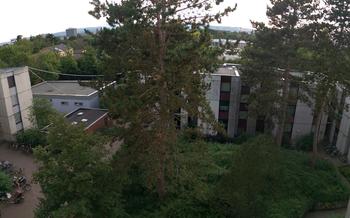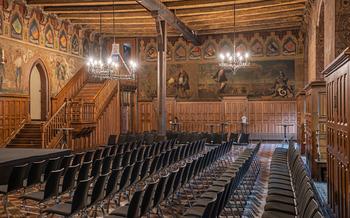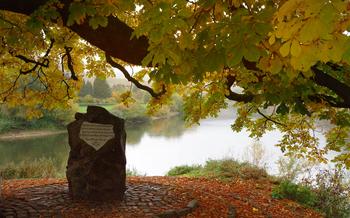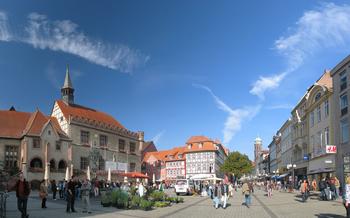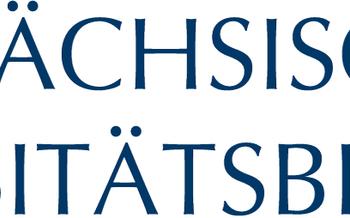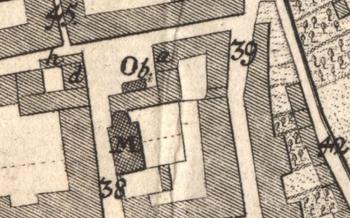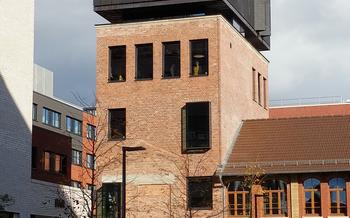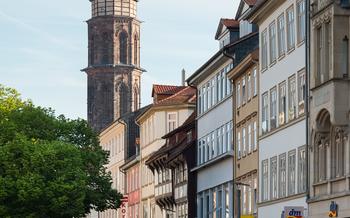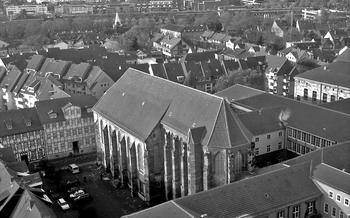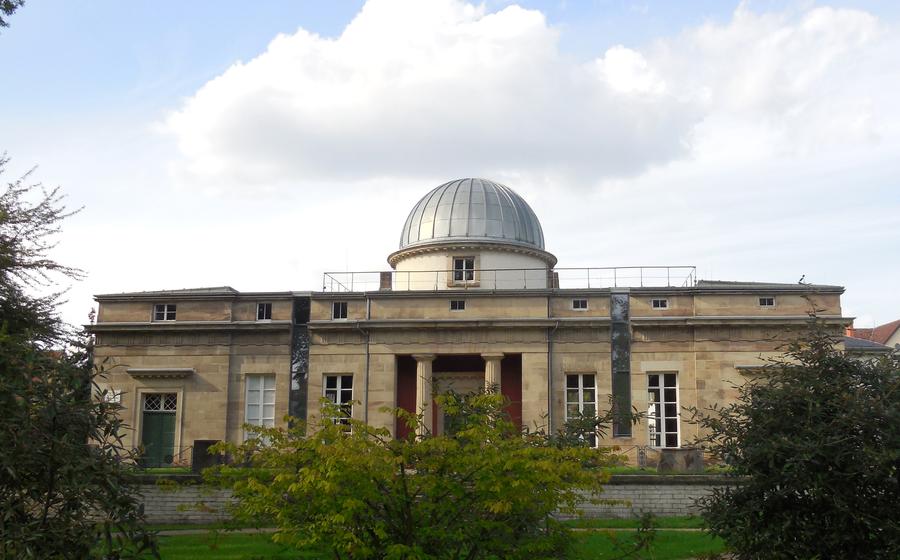
Göttingen Observatory
- Göttingen Observatory: A Journey Through the Cosmos
- Exploring the Observatory's History
- Marveling at the Observatory's Architecture
- Unveiling Scientific Discoveries Made at Göttingen
- Witnessing Cutting-Edge Research in Action
- Taking a Guided Tour of the Observatory
- Visiting the Observatory's Museum
- Observing the Night Sky at Göttingen
- Attending Lectures and Workshops
- Exploring the Observatory's Surroundings
- Planning Your Visit: Essential Information
- Capturing the Beauty of the Observatory
- Engaging with the Observatory's Online Presence
Göttingen Observatory: A Journey Through the Cosmos
Nestled in the heart of Göttingen, Germany, the Göttingen Observatory invites visitors on a captivating journey through the vast expanse of the universe. Founded in 1751, this renowned institution holds a significant place in the history of astronomy, boasting groundbreaking scientific discoveries and contributing to our understanding of the cosmos.
Historical Significance
The Göttingen Observatory traces its roots back to the 18th century when it was established as part of the University of Göttingen. Over the centuries, it has played a pivotal role in astronomical advancements, earning a reputation as one of the leading observatories in the world.
Architectural Features
The observatory's architectural design reflects the neoclassical style prevalent during its construction. The central dome, a prominent feature of the observatory, houses the historic refracting telescope. Surrounding the dome are various buildings that serve as offices, laboratories, and research facilities.
Scientific Discoveries
Throughout its illustrious history, the Göttingen Observatory has been the birthplace of numerous scientific discoveries. Notable achievements include pioneering work in celestial mechanics, contributions to understanding the structure and dynamics of the Milky Way, and the discovery of minor planets and comets.
Current Research
Today, the observatory continues to be at the forefront of astronomical research. Scientists at Göttingen are engaged in cutting-edge research in astrophysics, cosmology, and planetary science, using advanced instruments and collaborating with institutions worldwide.
Exploring the Observatory's History
The Göttingen Observatory, steeped in a rich legacy, was founded in 1751 by the University of Göttingen. It holds the distinction of being one of the oldest astronomical observatories in Germany and has played a pivotal role in the advancement of astronomy. In its early years, the observatory focused on observational astronomy, conducting meticulous observations of the night sky and contributing to the creation of accurate star catalogs.
Over the centuries, the Göttingen Observatory became a hub for renowned astronomers who made significant contributions to the field. Among them was Carl Friedrich Gauss, a mathematical genius who revolutionized celestial mechanics and developed new methods for calculating planetary orbits. Another notable figure was Wilhelm Olbers, who discovered two comets and proposed the Olbers' paradox, which questioned the darkness of the night sky in an infinite universe. These astronomers, along with many others, cemented the observatory's reputation as a leading center for astronomical research.
The Göttingen Observatory has carefully preserved historical instruments that tell the story of its past. Visitors can marvel at the original refracting telescope used by Gauss, as well as other antique telescopes, clocks, and measuring devices. These artifacts provide a tangible connection to the observatory's early years and offer a glimpse into the methods and techniques employed by astronomers of the past.
Marveling at the Observatory's Architecture
The Göttingen Observatory stands as a testament to the harmonious blend of scientific functionality and architectural elegance. Its neoclassical design, characterized by clean lines, symmetrical proportions, and understated ornamentation, reflects the prevailing architectural style of the 19th century. The central dome, a defining feature of the observatory, dominates the skyline and serves as a symbol of astronomical observation. Surrounding the dome are various interconnected buildings, each housing specific astronomical instruments and research facilities. The observatory's integration with the surrounding landscape is particularly noteworthy. Situated atop a hill overlooking the Leine Valley, the observatory offers panoramic views of the picturesque countryside, creating a serene and inspiring environment for scientific pursuits.
Unveiling Scientific Discoveries Made at Göttingen
The Göttingen Observatory has been at the forefront of astronomical advancements throughout its illustrious history. In the 19th century, under the directorship of Carl Friedrich Gauss, the observatory made significant contributions to celestial mechanics, developing new methods for calculating planetary orbits and predicting their positions. This work laid the foundation for modern astrodynamics.
In the early 20th century, astronomers at Göttingen focused on studying the structure and composition of the Milky Way galaxy. Walter Baade, a renowned astronomer who worked at the observatory, made groundbreaking discoveries about the nature of stars and the existence of two distinct stellar populations within our galaxy. These findings revolutionized our understanding of the Milky Way and its evolution.
Göttingen astronomers have also made notable contributions to the discovery of minor planets and comets. In the late 19th and early 20th centuries, observers at the observatory discovered numerous asteroids and comets, expanding our knowledge of the Solar System. These discoveries provided valuable insights into the origin and evolution of our cosmic neighborhood.
In recent decades, the Göttingen Observatory has played a significant role in modern astrophysics. Researchers have conducted extensive studies on the formation and evolution of galaxies, the nature of black holes and neutron stars, and the properties of extrasolar planets. Their work has contributed to our understanding of the universe's large-scale structure and the diversity of celestial objects that inhabit it.
Witnessing Cutting-Edge Research in Action
The Göttingen Observatory is not just a historical site but also a hub of ongoing scientific research. Astronomers and scientists from around the world collaborate here to push the boundaries of our understanding of the universe.
The observatory's telescopes and instruments are constantly trained on the cosmos, collecting data and making new discoveries. Researchers are involved in a wide range of projects, including studying the properties of stars and galaxies, exploring the mysteries of black holes and dark matter, and searching for exoplanets orbiting distant stars.
Visitors to the observatory have the unique opportunity to witness cutting-edge research in action. Public observing nights and events are held regularly, allowing astronomy enthusiasts to look through the telescopes and learn about the latest discoveries.
The observatory also collaborates with international institutions and universities, fostering a vibrant exchange of ideas and knowledge. Researchers from Göttingen have played a significant role in major scientific collaborations, such as the Event Horizon Telescope project, which captured the first image of a black hole.
The Göttingen Observatory's commitment to research and innovation ensures that it remains a vital center for astronomical discovery and exploration.
Taking a Guided Tour of the Observatory
The Göttingen Observatory offers guided tours that provide a fascinating glimpse into the world of astronomy and the observatory's rich history. These informative tours are conducted by knowledgeable guides who share insights into the observatory's scientific discoveries, architectural features, and ongoing research projects.
During the tour, you'll visit the observatory's historic buildings, including the iconic central dome, and learn about the instruments and techniques used by astronomers in the past. You'll also have the chance to view some of the observatory's most significant artifacts, such as the refracting telescope used by Gauss and the meridian circle used to measure the positions of stars.
The guided tour offers a unique opportunity to delve deeper into the observatory's scientific discoveries and understand the impact they have had on our understanding of the universe. You'll learn about the observatory's role in discovering minor planets and comets, its contributions to understanding the Milky Way, and its groundbreaking work in celestial mechanics.
To ensure a spot on a guided tour, it's advisable to book in advance, especially during peak tourist season. Tours typically last for around an hour and are offered on a regular basis, so you can easily find a time that suits your schedule.
Whether you're a seasoned astronomy enthusiast or simply curious about the wonders of the universe, a guided tour of the Göttingen Observatory is an enriching and unforgettable experience that will leave you with a newfound appreciation for the cosmos.
Visiting the Observatory's Museum
Nestled within the Göttingen Observatory's historic walls lies a treasure trove of astronomical knowledge and artifacts. The observatory's museum invites visitors on a journey through the cosmos, showcasing the rich history of astronomy and the groundbreaking discoveries made within these very walls.
Step into the museum's serene galleries, where time seems to stand still amidst the whisperings of the past. Marvel at the meticulously preserved historical instruments, each telling a tale of ingenuity and precision. Trace the evolution of telescopes, from the rudimentary refractors of yesteryear to the powerful modern instruments that have revolutionized our understanding of the universe.
Interactive exhibits and hands-on activities bring astronomy to life, engaging visitors of all ages in the wonders of the cosmos. Explore the mysteries of black holes, journey to distant galaxies, and unravel the secrets of the planets that dance around our sun. Learn about the pioneers of astronomy, whose tireless efforts and brilliant minds have shaped our understanding of the universe.
The museum not only serves as a repository of knowledge but also as a testament to the enduring human fascination with the night sky. Through its captivating displays and interactive experiences, the Göttingen Observatory's museum invites visitors to embark on a celestial adventure, igniting a passion for astronomy and inspiring generations to come.
Observing the Night Sky at Göttingen
The Göttingen Observatory offers a unique opportunity to explore the wonders of the cosmos through its public observing nights and events. Visitors can gaze upon the stars and planets through powerful telescopes, guided by experienced astronomers. These events provide an immersive experience, allowing participants to learn about constellations, deep-sky objects, and the latest astronomical discoveries. Whether you are a seasoned stargazer or simply curious about the night sky, these observing sessions are an unforgettable way to connect with the universe.
To ensure a successful visit, plan your night in advance. Check the observatory's website for event schedules and weather updates. Dress warmly, as temperatures can drop significantly at night, especially during winter. Consider bringing binoculars or a camera to enhance your stargazing experience.
Once at the observatory, take some time to adjust your eyes to the darkness. This will allow you to see fainter objects as your vision adapts. Listen attentively to the astronomers' explanations and feel free to ask questions. They are there to share their knowledge and help you make the most of your visit.
Whether you are witnessing the beauty of the Milky Way, marveling at the rings of Saturn, or catching a glimpse of a distant galaxy, a night sky observation at the Göttingen Observatory is an experience that will stay with you long after you return home.
Attending Lectures and Workshops
The Göttingen Observatory offers a range of educational and engaging opportunities for visitors to delve deeper into the world of astronomy. Regular lectures by renowned astronomers and experts provide insights into cutting-edge research and astronomical discoveries. These lectures cover a wide spectrum of topics, from the mysteries of the universe to the latest findings in astrophysics and cosmology.
In addition to lectures, the observatory also hosts workshops on astronomy and related topics. These workshops offer hands-on experiences and interactive learning sessions, allowing participants to engage with astronomical concepts and explore the cosmos in a practical way. Whether you're a beginner or an experienced astronomy enthusiast, the workshops provide an excellent platform for knowledge sharing, discussions, and networking with fellow astronomy enthusiasts.
To attend lectures and workshops, advance registration is recommended to secure your spot. Event details, including dates, times, and registration information, are available on the observatory's website. Don't miss this chance to learn from experts, ask questions, and immerse yourself in the fascinating world of astronomy at the Göttingen Observatory.
Exploring the Observatory's Surroundings
Nestled within the tranquil embrace of the Göttingen Botanical Garden, the Göttingen Observatory enjoys a picturesque setting. Visitors can lose themselves amidst the vibrant tapestry of flora and fauna, immersing themselves in the tranquility of nature while admiring the observatory's grandeur. The surrounding Leine Valley offers breathtaking panoramic views, inviting visitors to soak in the beauty of the region.
A short stroll from the observatory, the historic University of Göttingen beckons with its rich architectural heritage and academic legacy. Founded in 1737, the university has been a cradle of knowledge and innovation, contributing significantly to the field of astronomy. Visitors can delve into the university's storied past, exploring its museums, libraries, and lecture halls.
Combining a visit to the Göttingen Observatory with other attractions in the area creates a fulfilling and enriching experience. The city of Göttingen offers a plethora of cultural and historical landmarks, including museums, theaters, and art galleries. Visitors can embark on a culinary journey, savoring the flavors of local cuisine at charming cafes and restaurants. The surrounding countryside invites exploration, with scenic hiking trails, cycling paths, and idyllic villages waiting to be discovered.
Planning Your Visit: Essential Information
To ensure a smooth and enjoyable visit to the Göttingen Observatory, it is essential to plan ahead and consider the following information:
Operating Hours and Ticket Prices:
- The observatory is generally open to the public on specific days and times. It is advisable to check the official website or contact the observatory directly for up-to-date information on operating hours.
- Ticket prices may vary depending on the type of visit (guided tour, museum entrance, etc.) and any special events or exhibitions. It is recommended to purchase tickets in advance to avoid queues, especially during peak tourist seasons.
Accessibility and Visitor Facilities:
- The observatory is wheelchair accessible, and accessible restrooms are available on-site.
- Guided tours can be arranged in multiple languages upon request to accommodate visitors from diverse backgrounds.
- A small café and gift shop are located within the observatory's premises, offering refreshments and souvenirs to visitors.
Recommended Time of Year to Visit:
- The best time to visit the Göttingen Observatory is during the summer months (June to August) when the weather is pleasant, and the nights are clear for stargazing. However, the observatory offers a unique experience throughout the year, with different astronomical events and exhibitions to enjoy in each season.
Tips for Planning a Successful Visit:
- Advance booking for guided tours and workshops is highly recommended to secure your spot, especially for groups or during peak tourist seasons.
- Check the observatory's website for any special events, lectures, or workshops that may be of interest during your visit.
- Dress appropriately for the weather conditions, as the observatory is located in a semi-rural area, and temperatures can fluctuate.
- Bring binoculars or a small telescope if you plan to do some stargazing, as the observatory provides dark sky conditions ideal for observing the night sky.
Capturing the Beauty of the Observatory
The Göttingen Observatory offers a picturesque backdrop for photography enthusiasts, inviting visitors to capture the essence of this architectural gem. However, to ensure a harmonious coexistence between photography and the observatory's serene environment, certain guidelines and restrictions are in place.
Guidelines for Photography:
- Respect the Observatory's Environment:
-
Be mindful of the observatory's historical significance and the ongoing scientific research taking place. Avoid causing any disturbance or interfering with the work of astronomers.
-
Tripods and Equipment:
-
Tripods are generally permitted, but their placement should not obstruct the flow of visitors or pose a safety hazard.
-
Flash Photography:
-
Flash photography is strictly prohibited within the observatory's buildings to prevent damage to sensitive equipment and artifacts.
-
Commercial Photography:
- Commercial photography requires prior permission from the observatory's administration. Please contact the observatory in advance to obtain the necessary authorization.
Tips for Stunning Images:
- Golden Hour Magic:
-
Plan your visit during the golden hours of sunrise or sunset to capture the observatory bathed in a warm, ethereal light.
-
Experiment with Angles:
-
Explore different perspectives and angles to showcase the observatory's architectural details and its integration with the surrounding landscape.
-
Capture the Night Sky:
- If you're fortunate enough to visit on a clear night, set up your camera and tripod to capture the stars above the observatory's iconic dome.
Sharing Your Photos:
- Social Media Engagement:
-
Share your stunning captures on social media using the observatory's official hashtags to connect with a broader astronomy community.
-
Tag the Observatory:
- Tag the Göttingen Observatory in your posts to give credit to this historical institution and allow them to share your work with their followers.
Engaging with the Observatory's Online Presence
The Göttingen Observatory has an active online presence, providing astronomy enthusiasts and visitors with a wealth of information and resources. Through its official website and social media platforms, the observatory shares captivating content, including stunning images, videos, and educational posts about its history, research, and discoveries. Virtual tours offer a glimpse into the observatory's facilities and allow visitors to explore its exhibits and artifacts from the comfort of their own homes. The observatory's website also features astronomy-related articles, news, and event listings, keeping visitors up-to-date on the latest developments in the field. By engaging with the observatory's online community, visitors can connect with like-minded individuals, ask questions, and share their own astronomical experiences.
